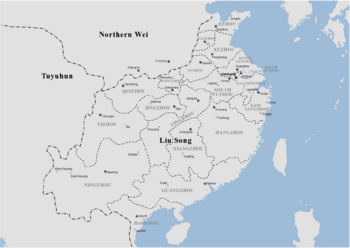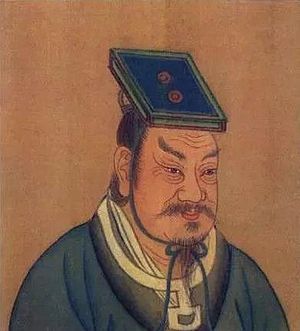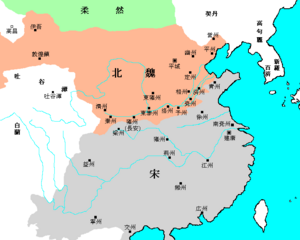Liu Song dynasty facts for kids
Quick facts for kids
Song
宋
|
|||||||||
|---|---|---|---|---|---|---|---|---|---|
| 420–479 | |||||||||

Liu Song and neighbors
|
|||||||||

Administrative divisions of Liu Song
|
|||||||||
| Capital | Jiankang | ||||||||
| Government | Monarchy | ||||||||
| Emperor | |||||||||
|
• 420–422
|
Emperor Wu | ||||||||
|
• 424–453
|
Emperor Wen | ||||||||
|
• 453–464
|
Emperor Xiaowu | ||||||||
| History | |||||||||
|
• Established
|
7 July 420 | ||||||||
|
• Disestablished
|
31 May 479 | ||||||||
| Currency | Chinese coin, Chinese cash |
||||||||
|
|||||||||
| Today part of | China Myanmar Vietnam |
||||||||
The Song dynasty, often called Liu Song (Chinese: 劉宋), was an important imperial dynasty in China. It was the first of the four Southern dynasties. This period was a time when China was divided into northern and southern parts. The Liu Song dynasty came after the Eastern Jin dynasty and before the Southern Qi dynasty.
The dynasty was started by Liu Yu (Emperor Wu), a powerful general. His family name, Liu, is added to "Song" to help tell it apart from a later, more famous Song dynasty (960–1279 CE). The Liu Song period lasted from 420 CE to 479 CE.
The Liu Song dynasty faced many challenges from within. Some emperors were not good leaders, or they were very strict and unfair. This often led to rebellions and fighting. However, the founder, Emperor Wu, was a brilliant military leader. The rule of the third emperor, Emperor Wen, was also a time of peace and good government. This peaceful time was known as the Reign of Yuanjia (425–453 CE). It was seen as a "golden age" for the Southern Dynasties.
Contents
History of the Liu Song Dynasty
How Liu Yu Rose to Power
Liu Yu came from a poor family, even though he was related to an earlier Han emperor. He joined the army when he was young and quickly became a skilled soldier. He was soon put in charge of an army unit. Liu Yu played a key role in defeating a rebel leader named Huan Xuan. After this victory, Liu Yu gained control over the Jin dynasty.
Liu Yu's Military Victories
Liu Yu is remembered as one of the best generals of his time. He worked to take back lands that China had lost during the Sixteen Kingdoms period. He first fought against Southern Yan, a state to the north that often attacked Jin. By 410 CE, he captured their capital, ending Southern Yan.
Next, he campaigned against Western Shu in what is now Sichuan. Using a clever military plan, Liu Yu surprised the Shu forces. He quickly captured their capital, Chengdu, bringing that area back under Chinese control.
After the death of the Later Qin emperor, Liu Yu attacked Later Qin. This state controlled important lands that had once been home to China's ancient capitals. Liu Yu defeated the Later Qin army in several battles. He also defeated an army from Northern Wei that came to help Later Qin. He successfully recaptured the important cities of Chang'an and Luoyang. These cities were former capitals of the Jin Empire.
After these successes, it seemed like Jin might reunite all of China. But things changed when Liu Yu had to return to Jiankang (modern-day Nanjing). He left his general in charge of the northern lands. After he left, the state of Xia attacked and took back the Guanzhong area. This meant Jin's border moved back to the Yellow River. However, Jin still held its former eastern capital, Luoyang, and much of the Chinese heartland.
Upon his return to Jiankang, Liu Yu officially ended the Jin dynasty. In 420 CE, he became emperor himself, starting the Liu Song dynasty. He named the dynasty after his own land, which was similar to an ancient state called Song. Liu Yu died in 422 CE. His son, Shaodi, became emperor but was quickly removed. His third son, Wendi, eventually became the next emperor.
Emperor Wen's Reign
Under Emperor Wen, the Liu Song economy grew strong. This period, known as the Yuanjia rule (Chinese: 元嘉之治), was famous for its wealth. It was a time of prosperity during 400 years of conflict between the Han and Tang dynasties. However, Emperor Wen was not as skilled in warfare as his father. He could not defeat the remaining northern states. This allowed Northern Wei to unite the North, which became a big problem for Liu Song. Northern Wei remained a constant threat.
Wars with Northern Wei
Emperor Wen continued his father's military campaigns, but he was not as successful. In 422 CE, he lost three areas to Wei. Later, under a skilled general, Liu Song took back four cities south of the Yellow River. But Emperor Wen did not push further. This allowed Wei to destroy Liu Song's ally, Xia. Emperor Wen made this mistake again by refusing alliances with other states against Wei. This led to Wei uniting the North in 439 CE, which was bad for the Chinese.
Later in his reign, Emperor Wen made poor decisions. He wrongly executed a key general, Tan Daoji, and took command himself. The empire's weakness showed in 450 CE when Emperor Wen tried to destroy Northern Wei. He launched a huge invasion. At first, it went well, but then it became a disaster. Wei tricked Liu Song into crossing the Yellow River, then attacked them from the side. The eastern army was destroyed. As Liu Song armies retreated, the lands south of the Yellow River were badly damaged by the Wei army. Only one strong city, Huatai, held out.
The economic damage was huge. The Wei troops destroyed the areas they occupied. A historian named Sima Guang wrote about it. He said that Emperor Wen's generals had to follow his exact battle plans. They even needed his approval for battle dates. This made the generals slow and unable to make quick decisions. Also, the new soldiers were not well trained. They would rush forward when winning but scatter when losing. These were the main reasons for the failure. After this, the Liu Song state began to decline.
Emperor Wen tried again to defeat Northern Wei in 452 CE but failed. When he returned to the capital, his son, Liu Shao, had him killed.
Emperor Xiaowu and Qianfei
Liu Shao's act of killing his father in 453 CE shocked the empire. It went against a very important principle of Chinese culture: respecting one's parents. His brother, Liu Jun, quickly rose up against him and defeated him. After Liu Shao was killed, Liu Jun became Emperor Xiaowu. Even though some people thought he was not a good person, his reign was fairly peaceful.
After Emperor Xiaowu died in 464 CE, his son, Liu Ziye, became emperor. He was known as a very strict and unfair ruler. He did not respect his father and was suspicious of his uncles, even having some of them killed.
Liu Zixun's Rebellion
The person who killed Liu Ziye became emperor and called himself Emperor Ming. He ordered Liu Ziye's brother and sister to end their own lives. However, his claim to the throne was not accepted by his nephew, Liu Zixun, who then started a rebellion.
At first, the civil war went very well for Liu Zixun. He quickly took control of almost the entire empire. But he moved too slowly. Emperor Ming quickly sent an army west and captured Kuaiji, an important food supply area. Another of his generals cut off Liu Zixun's supplies. Without food, Liu Zixun's troops collapsed, and he was killed at just 10 years old.
However, Emperor Ming became very proud and refused to forgive those who had supported Liu Ziye. This decision was very harmful to Liu Song. Many governors in the northern areas feared for their lives. They surrendered to Wei instead of facing execution. This led to the loss of important Chinese lands. These lands were the most fertile and developed at that time. This loss eventually led to the fall of the southern government. It also meant that North China remained under foreign rule for another 150 years. Emperor Ming tried to get these lands back, but he failed.
Emperor Ming's later rule was very harsh. He was suspicious of his nephews and had many of them killed. He also executed thousands of royal family members. This greatly weakened the royal family. When he died, his son needed help from a general named Xiao Daocheng. This was because almost all of Emperor Ming's brothers and nephews had been killed.
The Fall of Liu Song
Emperor Ming's successor, Emperor Houfei, did not like how much control Xiao Daocheng had over him. He openly said he would kill Xiao. Fearing for his life, Xiao had Emperor Houfei killed. He then placed Emperor Shun on the throne. In 479 CE, Xiao took the throne himself and declared himself Emperor of Qi. This ended the Liu Song dynasty. The former Emperor Shun and his family were soon killed.
A descendant of the Liu Song royal family, Liu Hui, fled north to the Xianbei Northern Wei state. He married a Xianbei princess. Many Xianbei princesses from Northern Wei married Han Chinese men from the southern imperial families. These families had moved north to join Northern Wei.
Literature and Culture

Even with all the fighting, the Liu Song dynasty was a time of great creativity. Many poems (shi) and rhapsodies (fu) were written. The emperors supported many literary works, and some even wrote themselves. Emperor Wen's court was especially active in writing. He supported the creation of a large collection of short stories called A New Account of the Tales of the World.
Three famous poets of the Song dynasty were Bao Zhao (died 466 CE), Xie Lingyun (385–433 CE), and Yan Yanzhi (384–456 CE). They are known for starting important new styles of writing.
Scientists and astronomers were also busy during peaceful times. Buddhism became more popular and better understood. Some officials, like Xie Lingyun, were Buddhists.
Liu Song artists also created many stone sculptures for tombs. These sculptures are typical of the Six Dynasties era. Only one group of sculptures has been confirmed to be from the Liu Song dynasty. These are the two qilin statues at the Chuning Tomb of the first emperor, Emperor Wu. They can be found in Qilin Town in Nanjing.
In 440 CE, the dynasty changed its official religion to Taoism, replacing Buddhism.
Science and Innovation
Zu Chongzhi, a famous astronomer and mathematician, lived during the Liu Song period. He was known for calculating pi (π) to seven decimal places. He also developed many other theories about astronomy.
Liu Song Emperors
| Posthumous name | Temple name | Family name and given names | Period of reigns | Era names and their according range of years |
|---|---|---|---|---|
| Wu, 武 | Gaozu (高祖) | Liu Yu, 劉裕 | 420–422 CE | Yongchu (永初) 420–422 |
| – | Liu Yifu, 劉義符 | 423–424 CE | Jingping (景平) 423–424 |
|
| Wen, 文 | Taizu (太祖) or Zhongzong (中宗) | Liu Yilong, 劉義隆 | 424–453 | Yuanjia (元嘉) 424–453 |
| – | Liu Shao, 劉劭 | 453 | Taichu (太初) 453 | |
| Xiaowu, 孝武 | Shizu 世祖 | Liu Jun, 劉駿 | 453–464 | Xiaojian (孝建) 454–456 CE Daming (大明) 457–464 |
| – | Liu Ziye, 劉子業 | 464–465 | Yongguang (永光) 465 CE Jinghe (景和) 465 |
|
| Ming, 明 | Taizong (太宗) | Liu Yu, 劉彧 | 465–472 | Taishi (泰始) 465–471 CE Taiyu (泰豫) 472 |
| – | Liu Yu, 劉昱 | 473–477 CE | Yuanhui (元徽) 473–477 CE |
|
| Shun, 順 | – | Liu Zhun, 劉準 | 477–479 CE | Shengming (昇明) 477–479 CE |
Liu Song Family Tree
| Liu Song | ||||||||||||||||||||||||||||||||||||||||||||||||||||||||||||||||||||||||||||||||||||||||||||||||||||||||||||||||||||||||||||||||||||||||||||||||||||||||||||||||||||||||||||||||||||||||||||||||||||||||||||||||||||||||||||||||||||||||||||||||||||||||||||||||||||||||||||||||||||||||||||||||||||||||||||||||||||||||
|---|---|---|---|---|---|---|---|---|---|---|---|---|---|---|---|---|---|---|---|---|---|---|---|---|---|---|---|---|---|---|---|---|---|---|---|---|---|---|---|---|---|---|---|---|---|---|---|---|---|---|---|---|---|---|---|---|---|---|---|---|---|---|---|---|---|---|---|---|---|---|---|---|---|---|---|---|---|---|---|---|---|---|---|---|---|---|---|---|---|---|---|---|---|---|---|---|---|---|---|---|---|---|---|---|---|---|---|---|---|---|---|---|---|---|---|---|---|---|---|---|---|---|---|---|---|---|---|---|---|---|---|---|---|---|---|---|---|---|---|---|---|---|---|---|---|---|---|---|---|---|---|---|---|---|---|---|---|---|---|---|---|---|---|---|---|---|---|---|---|---|---|---|---|---|---|---|---|---|---|---|---|---|---|---|---|---|---|---|---|---|---|---|---|---|---|---|---|---|---|---|---|---|---|---|---|---|---|---|---|---|---|---|---|---|---|---|---|---|---|---|---|---|---|---|---|---|---|---|---|---|---|---|---|---|---|---|---|---|---|---|---|---|---|---|---|---|---|---|---|---|---|---|---|---|---|---|---|---|---|---|---|---|---|---|---|---|---|---|---|---|---|---|---|---|---|---|---|---|---|---|---|---|---|---|---|---|---|---|---|---|---|---|---|---|---|---|---|---|---|---|---|---|---|---|---|---|---|---|---|---|---|---|
|
||||||||||||||||||||||||||||||||||||||||||||||||||||||||||||||||||||||||||||||||||||||||||||||||||||||||||||||||||||||||||||||||||||||||||||||||||||||||||||||||||||||||||||||||||||||||||||||||||||||||||||||||||||||||||||||||||||||||||||||||||||||||||||||||||||||||||||||||||||||||||||||||||||||||||||||||||||||||
See Also
- Chinese sovereign
- History of China
- Six Dynasties
- Song dynasty
- Southern and Northern Dynasties






